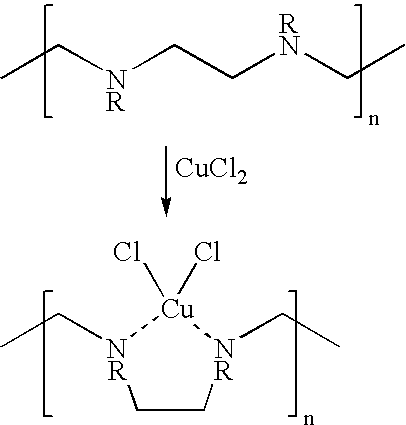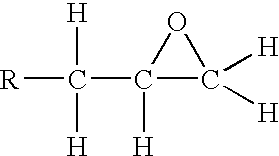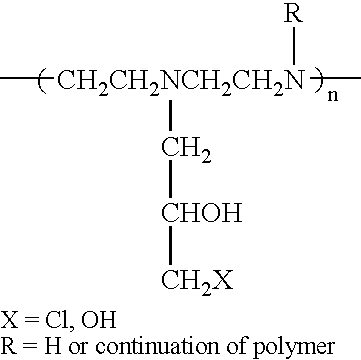Method for reducing odor using coordinated polydentate compounds
a polydentate compound and odor reduction technology, applied in the field of odor control additives, can solve the problems of ineffective conventional odor control compositions, such as described above, in obtaining the full level of odor control desired in many applications, and achieve the effect of facilitating crosslinking and facilitating application to certain types of substrates
- Summary
- Abstract
- Description
- Claims
- Application Information
AI Technical Summary
Benefits of technology
Problems solved by technology
Method used
Image
Examples
example 1
[0064] The effectiveness of the odor control composition of the present invention to adsorb odorous compounds was demonstrated. A polyethyleneimine solution was initially prepared by dissolving 3.3 grams of branched polyethyleneimine (obtained from Polyscience, MW=10,000 daltons) in 900 milliliters of deionized water. Thereafter, 335 milligrams of copper chloride (obtained from Aldrich, 97 wt. %) was added to the polyethyleneimine solution. Upon addition of copper chloride, the solution turned deep blue, indicating the formation of a coordination complex. A piece of a Scott® paper towel was then immersed in the solution for 1 minute and allowed to dry in air. The solids add-on level was 5.8%. The product was tested for odor adsorption using 1 microliter of ethyl mercaptan (0.839 milligram) as described above. The % odor reduction was determined to be 85.4%. In a parallel test, a control sample (piece of untreated Scott®) paper towel) reduced only 11.0% odor.
example 2
[0065] The effectiveness of the odor control composition of the present invention to adsorb odorous compounds was demonstrated. A polyethyleneimine solution was initially prepared by dissolving 132.5 milligrams of branched polyethyleneimine (obtained from Polyscience, MW=1,800 daltons) in 105 milliliters of deionized water. 5 milliliters of this solution was mixed with 300 milliliters of 2% aqueous solution of Snowtex-O particles, which are colloidal silica nanoparticles commercially available from Nissan Chemical America of Houston, Tex. The particles have an average particle size of between 10 to 20 nanometers and a surface area between 180 to 240 square meters per gram. Thereafter, 275 milligrams of copper chloride (obtained from Aldrich) was added to the polyethyleneimine / silica suspension. Upon addition of copper chloride, the solution turned deep blue, indicating the formation of a coordination complex.
[0066] To test the effectiveness in which the copper chloride and polyethy...
example 3
[0068] The effectiveness of the odor control composition of the present invention to adsorb odorous compounds was demonstrated. A polyethyleneimine (PEI) solution was initially prepared by dissolving branched polyethyleneimine (obtained from Polyscience, MW=10,000 daltons) in deionized water to obtain solutions with varying polyethyleneimine concentrations. Thereafter, a metal salt was combined with the polyethyleneimine solution. Various metal salts were tested, including iron (III) chloride (FeCl3), zinc sulfate (ZnSO4), copper chloride (CuCl2), and silver sulfadiazine (AgSDZ) along with sodium benzoate (NaBZ) and sodium salicylate (NaSC). The salts were tested at various concentrations.
[0069] The PEI-metal complexes (copper, iron (III), and zinc) were prepared by simply dissolving the corresponding metal salts in the PEI solution. To prepare the PEI-Ag complex, 500 milligrams of AgSDZ, 1 gram of NaBZ, and 1 gram of NaSC were added to 1 liter of water. 10 grams of PEI (obtained f...
PUM
| Property | Measurement | Unit |
|---|---|---|
| surface area | aaaaa | aaaaa |
| size | aaaaa | aaaaa |
| particle size | aaaaa | aaaaa |
Abstract
Description
Claims
Application Information
 Login to View More
Login to View More - R&D
- Intellectual Property
- Life Sciences
- Materials
- Tech Scout
- Unparalleled Data Quality
- Higher Quality Content
- 60% Fewer Hallucinations
Browse by: Latest US Patents, China's latest patents, Technical Efficacy Thesaurus, Application Domain, Technology Topic, Popular Technical Reports.
© 2025 PatSnap. All rights reserved.Legal|Privacy policy|Modern Slavery Act Transparency Statement|Sitemap|About US| Contact US: help@patsnap.com



